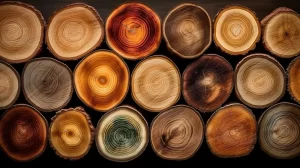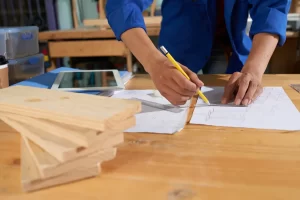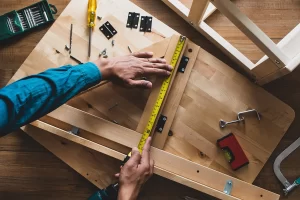Outdoor woods are far less plentiful than indoor wood. Choosing the wrong wood for your outdoor projects can be detrimental for your project. There are issues such as pests, weather, fraying, constant refinishing, and environemntal issues that can come with choosing the incorrect wood for outdoor projects.
In this article, we will discuss what you need to consider when choosing the right wood for your outdoor projects. If you have a woodworking project that has a final end use outdoors, don’t start until you finish reading this article.
What To Consider Before Your Start
Cost and Accessibility
Evaluating the availability and cost of wood in your vicinity is crucial. While exotic hardwoods might offer unparalleled quality and durability, they can be prohibitively expensive and not readily available. In contrast, woods sourced locally are often more affordable and accessible.
Balancing cost with quality is essential to ensure the success of the project without overshooting the budget. Consider researching various suppliers and comparing prices to find the best deals on quality woods that meet your project’s requirements.
Density and Hardness
Wood with high density and hardness is synonymous with durability, especially in outdoor conditions where the material needs to withstand various elements. Tropical hardwoods like ipe, teak, and mahogany are distinguished for their hardness, making them ideal candidates for projects demanding resilience.
These woods, although typically more expensive, provide a robust and long-lasting foundation, making them a valuable investment for outdoor structures. The dense nature of these woods also implies less susceptibility to scratches and dents, maintaining the aesthetic appeal over time.
Maximum Single Piece Sizing
When cut from trees, woods come in different varieties of sizes ad dimensions based on how the tree grows. The size of the trunk and the branches will determine how large of a piece of wood you can extract from a tree. This may affect the sizing of your project or even the aesthectic of the wood.
Consider a tale to be put outside. It may have a top that’s made of a single slab of redwood. This may be difficult with other types of wood and will require gluing or fastening parts together to make a single piece as desired.
Maintenance Needs
Different woods have varying maintenance requirements. The upkeep needed to maintain the wood’s appearance and durability is a vital consideration. Some woods may necessitate regular applications of sealants, stains, or oils to preserve their condition and appearance over time.
Assessing maintenance needs beforehand is crucial, as it influences the overall cost and effort involved in keeping the wood in optimal condition. A well-maintained piece can prolong the lifespan of the wood, ensuring that the beauty and functionality of your project endure.
Aesthetic Qualities
When selecting wood, aesthetics play a significant role. Each wood type has unique grain patterns and colors that can enhance the overall appearance of your project. Woods with natural beauty and distinctive grains can contribute significantly to the visual appeal of your outdoor structures.
Considering aesthetics is not just about the initial appearance but also about how the wood ages over time. Some woods may develop a patina or change color, impacting the overall look of the project. Selecting wood with enduring aesthetic appeal is crucial for long-term satisfaction.
Enhancement Treatments
Some woods benefit from chemical treatments, like pressure-treated pine, to augment their resistance to decay and insects. When opting for treated woods, it’s crucial to verify that the chemicals used are suitable and safe for outdoor applications, avoiding any potential harm to the environment or users.
Careful consideration of treatment options is necessary, weighing the benefits of enhanced durability against any potential drawbacks or environmental impacts. It’s also vital to ensure that the treatment doesn’t compromise the wood’s natural appearance or structural integrity.
Resistance to Moisture
Outdoor woods should inherently resist moisture, preventing water absorption that can lead to warping, rotting, and splitting. Redwood, cedar, and several tropical hardwoods exhibit natural moisture-resistant properties, ensuring their stability and longevity in varying weather conditions.
Choosing such moisture-resistant woods is particularly important in humid climates where the exposure to moisture is constant. Such choices help in maintaining the structural and aesthetic integrity of the outdoor projects, reducing the need for repairs and replacements due to moisture damage.
Eco-friendly and Sustainable Choices
It is imperative to opt for woods that are sourced responsibly from sustainably managed forests. Choosing eco-friendly options is not only ethical but also ensures the conservation of vital ecosystems. Look for certifications like the Forest Stewardship Council (FSC) to confirm responsible harvesting practices.
The focus on sustainability extends to considering the entire lifecycle of the wood, from sourcing to disposal. Opting for wood that is sustainably sourced and has a minimal environmental impact contributes to responsible consumption and the overall well-being of the planet.
Inherent Decay and Pest Resistance
When opting for wood for outdoor projects, it’s crucial to select varieties known for their inherent resistance to decay and pests. Such woods possess natural oils or substances that act as deterrents to insects, ensuring longevity. Cedar, redwood, and cypress are prime examples of woods with inherent resistances, renowned for their ability to stand against pest infestations effectively.
Moreover, understanding the specific pest-resistant properties of each wood type is essential, as it allows for informed decisions based on the particular requirements of the project. Researching and selecting the appropriate wood not only ensures the structural integrity of your outdoor project but also minimizes potential damage and maintenance related to pest infestations.
Intended Purpose and Usage
When selecting wood, the intended application should guide your choice. For example, wood intended for a deck should be able to withstand heavy foot traffic and frequent exposure to the elements. For furniture, the wood should be resilient to varying weather conditions and possibly lighter for easy relocation.
The specificity of application is key, as it dictates the required properties of the wood, such as hardness, density, and moisture resistance. A well-thought-out selection, based on intended use, guarantees the functionality and longevity of the project.
Harmony with Fasteners and Coatings
Each wood type may interact differently with various fasteners or finishes, influencing the assembly and final appearance of the project. Compatibility is crucial to avoid any adverse reactions between the wood and applied finishes or used fasteners, ensuring the longevity and aesthetic appeal of the project.
Selection should involve consideration of the wood’s compatibility with the intended finishes and fasteners, avoiding any potential damage or aesthetic inconsistencies. This careful matching ensures a harmonious integration of all components, contributing to the project’s success.
Local Weather Factors
Local climate is a significant factor influencing the selection of wood for outdoor projects. In regions with high humidity or extreme temperature variations, woods with high moisture resistance and dimensional stability are crucial to prevent degradation over time.
The selection should also factor in exposure to sunlight, rain, and snow, as different woods have varying levels of resistance to these elements. Proper research and consideration of local weather conditions ensure that the selected wood performs optimally and maintains its integrity and appearance over time.
Professional Consultation
If there are uncertainties or lack of clarity, consulting with professionals like carpenters or lumber specialists is advisable. Expert advice can provide insights and recommendations tailored to the specific needs and conditions of your project and location, ensuring the optimal selection of wood.
Such consultations can also provide valuable insights into the local availability, cost, and suitable wood types, facilitating informed decisions that contribute to the project’s success. Leveraging professional knowledge is a proactive step in avoiding potential pitfalls and ensuring the longevity and success of your outdoor project.
Conclusion
When selecting wood for outdoor projects, consider factors such as natural resistance to decay, hardness, moisture resistance, treatment options, availability, aesthetics, environmental impact, maintenance needs, local climate, intended application, and compatibility with other materials.
Making informed decisions based on these factors will help in the successful completion of your outdoor projects. Keep sustainability in mind and opt for certified, responsibly sourced options whenever possible. And finally, don’t hesitate to consult with professionals for expert advice tailored to your specific needs and locality.










